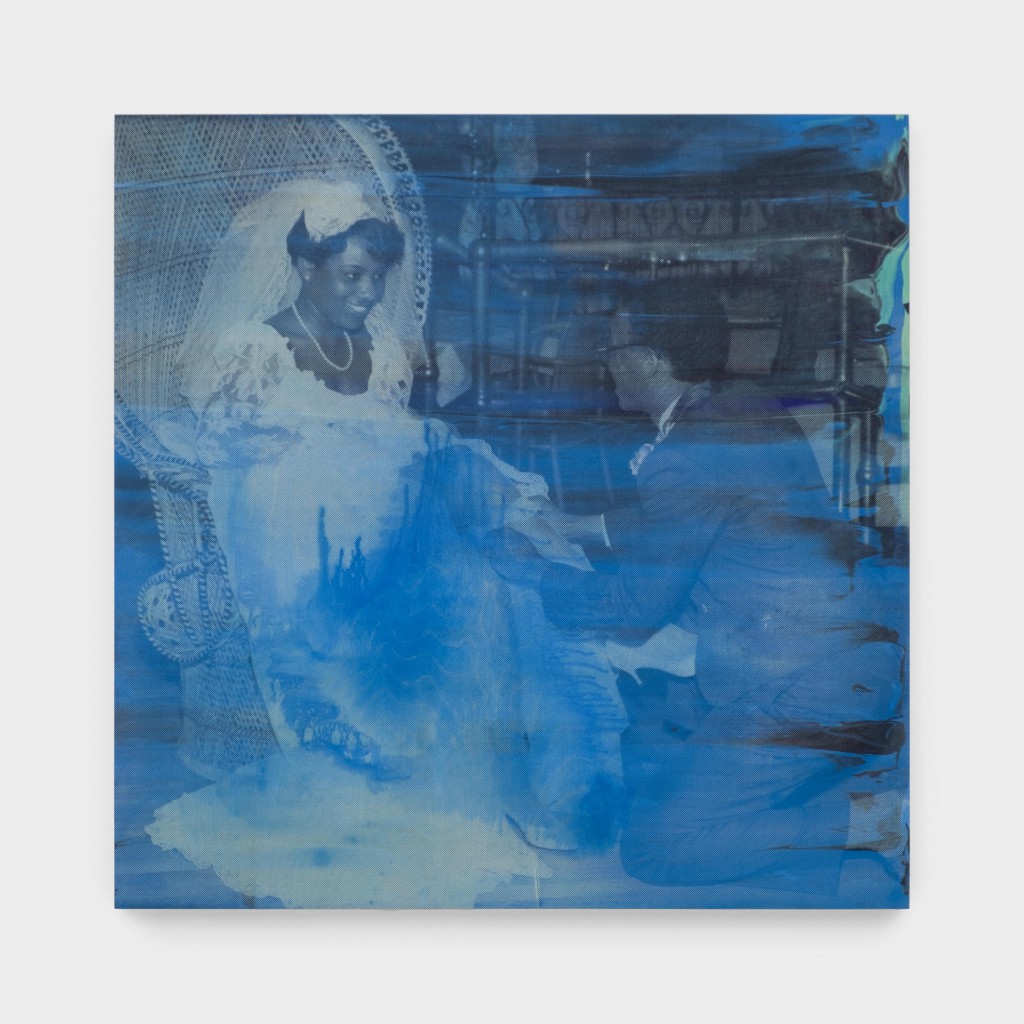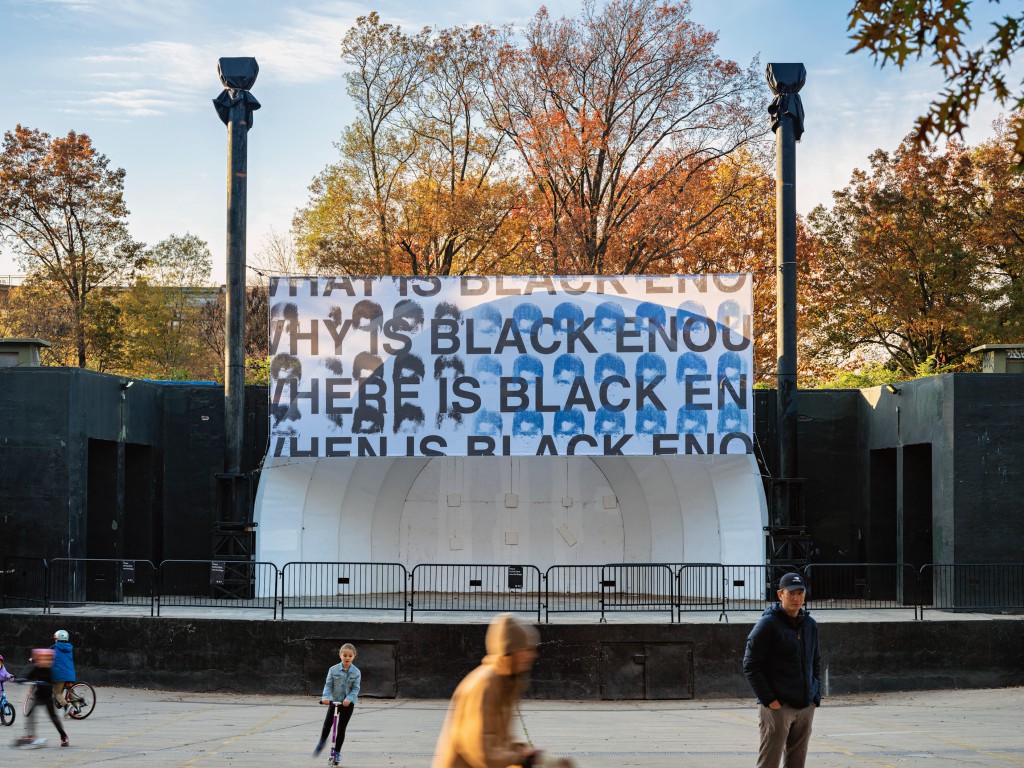In Kevin Claiborne’s multimedia work, he sources from personal archives, landscape, and anthropological studies to coalesce a vision of Black American history into its contemporary variations, spanning the realms of collective and private histories. “Starting with the gaps in my own family history, and the space between ‘what I know vs. what I should know,’ the missing information between where my ancestors come from and where I am today, I am digging and mining the sediment of histories, passed down, erased, and avoided,” he writes. In “BLACK ENOUGH,” his 2020 exhibition at Thierry Goldberg, he poses a series of questions against the landscapes of Joshua Tree. Some of his questions, such as “Is Black enough?” and “When is Black enough?,” are clipped in the frame, leaving the sentences unfinished, like the Black lives that are prematurely cut short. Extending his reflections on Black identity and memory, Claiborne’s 2023 exhibition, “Family Business,” took a slightly different turn. Drawing from a box of family photographs, he applied green and blue pigments to the images, condensed moments in which his mother, beaming with a radiant smile, once gazes affectionately at his father. The result is a heightened revision of his family archive, a rediscovery of the ties that bind him to his kinsfolk: their shared passions, dreams, and tears. In this following interview, he speaks on materiality, capturing Black lives in Black contexts, and embedded dialogues within his visuality.
Junyi Zhou (JZ): From the beginning of your career, you’ve combined written texts with visual materials. How did this idea come to you initially?
Kevin Claiborne (KC): For as long as I can remember, I’ve had an interest in the power of words—their potential, their malleability, their limitations, and their ability to shape meaning. I’ve always been impressed with people who have mastered their expression of the written word, and who understand how to literally and metaphorically paint with text. My earliest inspirations were graffiti artists, poets, and rappers, all of whom understood the nuances of language, how the weight of words changes with scale, and how to use text as a material.
When I first started using photography and archival images in a conceptual manner, incorporating text seemed like a logical next step. Words change meaning depending on present context, and context can change depending on the words that are present.
JZ: I know that you started out as a photographer. How do you see your multimedia/cross-media approach? Does it impose certain limitations on your objective (if there is one) as an artist, or is it the ultimate means for you to channel your message?
KC: Sometimes my mixed-media or multimedia approach offers the ability to enhance and increase the complexity of my work, and other times, it shifts the focus from the material composition of the work to the ideas embedded within. Every material has a story, a purpose, a history, and a language or logic to its usage. Sometimes, the material becomes the focus, and sometimes certain material combinations allow the viewer to have more entry points into appreciating, understanding, or engaging with the work. It depends on the context.
I try to always start with the idea, the concept, and let that determine whatever materials, if any, are necessary. I don’t always subscribe to the hierarchies of mediums that often exist within discourse on visual art, and I believe, when working conceptually, it’s imperative to remain fluid and flexible in the ways in which ideas are made manifest. The ultimate means is to rid myself of limits. I cannot limit my art any more than I can limit my love for the world and everything within it.
JZ: The Black experience is central to your body of work. Can you point us to one or two pieces of your work that you feel as representative of your formal and thematic concerns?
KC: There are so many different Black experiences that I reference in my work that I hesitate to point to any singular piece. Lately, the work from my ongoing “Family Business” series has been most transformative. I’ve recently continued that series on mirrored surfaces, and they’re quite difficult to photograph, but I enjoy their refusal to be “captured.”
JZ: In her introduction to your exhibition “Family Business,” Angela N. Carroll calls your “acts of distortion”—the use of glitch, negative space, warp, and tint—as a form of “attentive gestural mark-making.” Is superimposing texts onto images and photographs another form of mark-making? For you, does it in any way differ from the other “acts of distortion,” to borrow Carroll’s formulation?
KC: The text superimposed on my images is certainly a form of mark-making, just as the drips of acrylic and ink are. They’re simply another method for the visual elements to be in dialogue with one another. The text I use does not appear simply to narrate a scene or describe something; they are integral pieces of the entire composition, and whether or not they serve as “acts of distortion” depends on their placement in relation to the work’s other elements. I’m interested in how the layering of text and image can create or disrupt tension, structure, rhythm, perception, and interpretation.

Commitment?, 2023
Acrylic and ink on wood panel
JZ: Before “Family Business,” you’ve worked primarily with a monochrome palette. Can you talk a little about color in your work?
KC: I initially began making work with a very restricted palette for a few reasons. I wanted to reference Black and Blackness through the color and the word “black” without allowing other colors to be a distraction. I also wanted to simplify my process. Lately, I’ve been using a lot more shades of blue, as a color that reminds me of my mother and a dream she shared with me.
JZ: Your exhibition “Landscape of Lost Histories” was housed in the Public Service Gallery in Stockholm, and “LOST BOYS”—to me a continuation of “Landscape of Lost Histories”—was presented in Brooklyn’s Prospect Park. What did the change in exhibition space reveal or inform about your work and more specifically, about the content of these two exhibitions?
KC: LOST BOYS was presented by BRIC in Prospect Park, and I was proud to share my work in a format that allowed it to be experienced outside of traditional art venues such as galleries or museums. I’m extremely proud any time my art can be more visible and more accessible, because more people can engage with it and it has the opportunity to become a part of public discourse, provoking dialogue in a public setting. Also, the scale of the work made me realize that some of my ideas need to be larger, in order to literally become part of a landscape. There was a lot of labor, communication, and compromise involved in the planning, installation, and deinstallation, which helped me realize that it’s okay to ask for help in bringing ideas to life—that I don’t have to work alone. Asking for help can be a revolutionary and liberating act.

Lost Boys, 2023
Presented by BRIC and Prospect Park Alliance, in partnership with NYC Parks’ Art in the Parks program
JZ: Can you tell us a bit about your future projects? Any plans to take on new directions and approaches?
KC: I’ll be showing work at CHART Art Fair in Copenhagen this August and continuing to experiment in the studio for the rest of the year. I’d also like to publish a zine or book with some of my text and image work together within the next year.
Kevin Claiborne is a multidisciplinary conceptual artist whose work examines intersections of identity, social environment, and mental health within the Black American experience. Moving between collage, silkscreen, photography, painting, and sculpture, while frequently using language as material, Claiborne is interested in finding new ways to look at history and its connection to the present. Claiborne holds a B.S. in Mathematics from the historically Black college North Carolina Central University (2012), an M.S. in Higher Education from Syracuse University (2016), and an MFA in Visual Arts from Columbia University (2021).
Junyi Zhou is a writer and an Assistant Editor (Visual) at Asymptote. She received her BA from Vassar College and MPhil from the University of Cambridge, concentrating on English and film studies. Her published work can be found in Mediapolis.
*****
Read more on the Asymptote blog:

